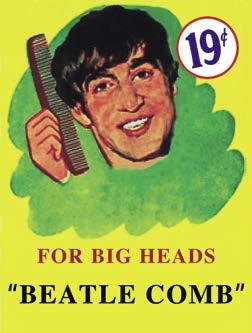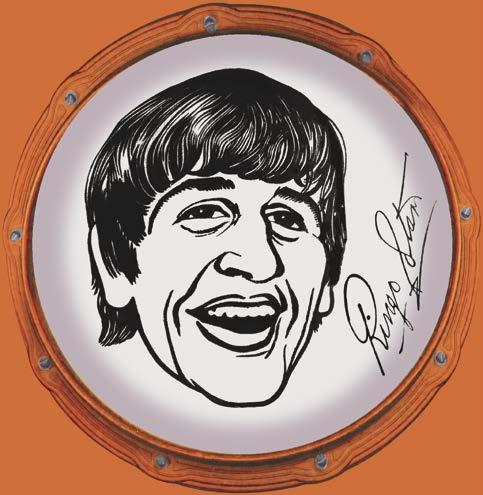
10 minute read
The Rolling Stones
It’s official! Sanctioned comics
What really sets Dell Publishing’s “official” 35-cent giant comic book The Beatles apart is the fact that its artist made the effort to capture the likenesses of John, Paul, George and Ringo.
That artist was Joe Sinnott (1926-2020), a prolific inker for Marvel Comics who delineated more than 200 issues of Fantastic Four, chiefly pencilled by Jack Kirby and John Buscema.
Sinnott explained that his penchant for likenesses is what landed him the Beatles gig.
“I secured an account over at Dell and also at Treasure Chest,” Sinnott told me in 2004. “I was fairly fortunate to be able to capture likenesses, so the companies used to give me a lot of biographical stories, which I certainly enjoyed. I did the lives of (Douglas) MacArthur and (Dwight) Eisenhower and John Kennedy and Babe Ruth and the popes and J. Edgar Hoover.
“Dell liked the way I did likenesses. So for Dell, I did the life of the Beatles. That was a 64-page book, a lot of work,” added Sinnott (who drafted Dick Giordano to do some pages).
Capturing the look of the Beatles took some hustle on Sinnott’s part, the artist recalled. “As far as references, I was given nothing,” he said. “I relied on photos in magazines.”
It was a point of pride for Sinnott to draw the Beatles’ locations, and their gear, correctly. “I felt it was important to get the instruments right,” he said. “I didn’t want to just fake it.”
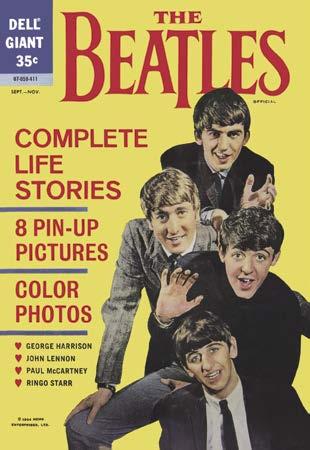
Ah, romance
CHARLTON SHAMELESSLY PLAYED the Beatles card in its romance titles. In stories like “The Beatles Were My Downfall” (from Summer Love #46, 1965) and “The Beatles Saved My Romance” (from Summer Love #47, 1966), the heroines learn not to put their unattainable idols ahead of the actual flesh-and-blood fellows who are right in front of them. Ain’t that sweet?
Publishers of romance comics sometimes shoe-horned the Fab Four onto its covers. The poster for a Beatles “record hop” on the cover of Charlton’s Teen Confessions #31 (1964) appears to be an afterthought. The cover of DC Comics’ Heart Throbs #101 (1966) depicts a young lady tearfully discovering that her boyfriend is cheating on her ... while attending a Beatles movie.
In the Archie Comics line, Betty and Veronica went gaga over the Fab Four. On the cover of Laugh #166 (1965), they swoon over the group. In Betty and Veronica #105 (1965), they attend a Beatle wig sale. Meanwhile, in another Archie Comics title, Josie #28 (1965), Josie’s well-decorated bedroom is a tribute to Herman’s Hermits.
EVEN ODDER THAN THE ROMANCE comic book appearances were the Beatles’ crossovers and tie-ins with superheroes.
In DC Comics’ Superman’s Pal Jimmy Olsen #79 (1964), Jimmy is hijacked to the distant past, where he manufactures and sells Beatle wigs to peasants. When Superman sees Jimmy in his red wig playing a ram’s horn and drum, he exclaims, “You’ve really started a ‘Beatle’ fad here, Jimmy! You seem to be as popular as Ringo, the Beatle drummer!” (You could always count on editor Mort Weisinger to spell it out for you.)
Jimmy’s second Beatles-related — or, at least, Beatles-adjacent — adventure happened in Jimmy Olsen #88 (1965). Despite the promise of a Beatles connection on the cover, there are no Beatles — just Rick Rock and His Rolling Romeos, which Olsen challenges with his own combo, Jimmy Olsen and His Carrot-Top CutUps. Jimmy arranges a front-page story about his group in The Daily Planet. So journalistic ethics did not exist in 1960s Metropolis.
In Metal Men #12 (1965), the Beatles’ dialect sounds more Knightsbridge than Liverpool. I say!
In Marvel Comics’ Strange Tales #130 (1965), the Human Torch and the Thing pursue a trio of thieves who abscond to Coney Island with the band’s payroll — wearing Beatle wigs.
Charlton Comics Beatles tie-ins, from top: Summer Love #46 (1965), Teen Confessions #31 (1964) and Summer Love #47 (1966).
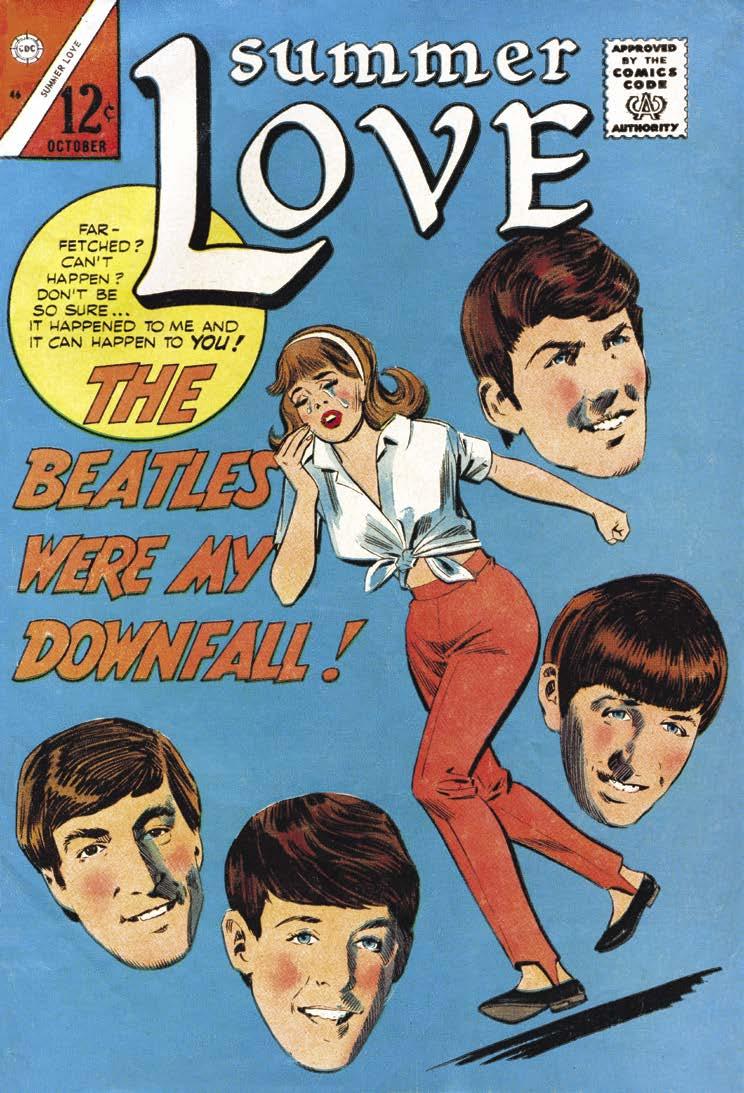
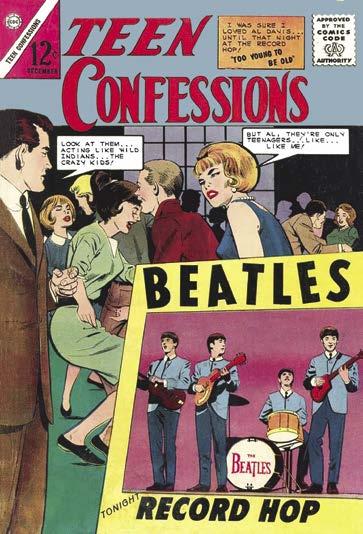
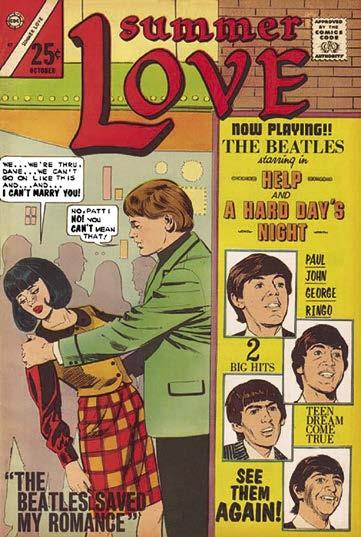

Beatles in the DCU
Above: The most famous band in the world meets the least famous superteam in the world, in Metal Men #12 (1965). This really is an alternate universe, in which the Beatles, in their first flush of world fame, beg the Metal Men — who were not exactly the Justice League of America — for their autographs. (Tina, then the Metal Men’s sole female member, asks the all-important question: “Is your hair real?”) Story by Robert Kanigher; art by Ross Andru and Mike Esposito. Opposite and right: In Superman’s Pal Jimmy Olsen #79 (1964), the first panel of “The Red-Headed Beatle of 1000 B.C.!” encapsulates the head-scratching weirdness of the Jimmy Olsen comic book series. Jimmy wears a red Beatle wig and dances as he watches the Beatles on TV, exclaiming, “I always seem to enjoy their music more when I wear my personal Beatle wig!” Story by Leo Dorfman; cover by Curt Swan and George Klein; interior art by George Papp. © DC Comics Inc.


Sinister swinger
Left: That brazen British baddie, the Mad Mod, ensnares Kid Flash in a panel from Teen Titans #7 (1967). In “The Mad Mod, Merchant of Menace,” the Titans are enlisted to accompany Wonder Girl’s favorite English pop star, Holly Hip, and break up a smuggling operation spearheaded by the Mad Mod, a haberdasher for London’s swinging set who says things like “Jolly good show!” and “Cheerio!” Story by Bob Haney, art by Nick Cardy. The Mad Mod returned in Teen Titans #17 (1968), taunting the Titans, “Aye, me duckies, it’s your old friend!” Haney and Cardy were reteamed. © DC Comics Inc.

From screen to page
Above: The TV sitcom “My Little Margie” (1952-55) was long off the air by 1964, but Charlton Comics continued publishing a comic book based on the series, thus Margie’s Beatle moment. Right: Another officially sanctioned Beatles comic book was Dell’s “Yellow Submarine” movie adaptation of 1968. Below: The “Sgt. Pepper”-era Beatles meet Forbush-Man in Marvel Comics’ superhero parody comic book Not Brand Ecch #8 (1968), in artwork by Tom Sutton.
© Charlton Comics Group; © King Features-Subafilms, LTD.; © Marvel Comics
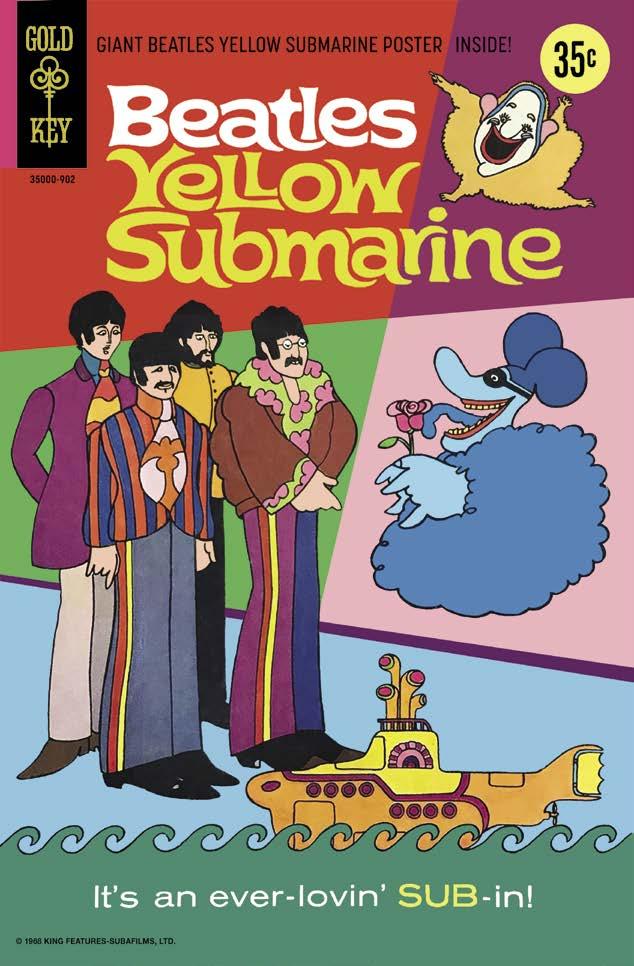

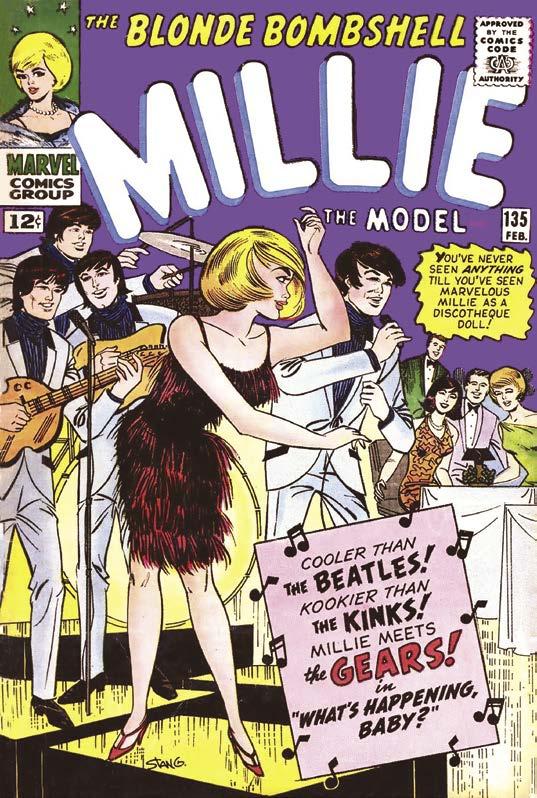


The Gears are ... gear!
Cooler than the Beatles? Kookier than the Kinks?
That’s what the cover type of Millie the Model #135 (1966) promised regarding the Gears, Marvel’s fictional quartet based on real-life British Invasion bands.
Writer Roy Thomas (creator of the Gears with artist Stan Goldberg) said he didn’t recall discussing the Gears with Marvel Comics editor Stan Lee “in any way, shape, or form,” when we corresponded in 2021.
“It was an idea I brought up to Stan Goldberg, who was the penciler and had been, I suspect, basically doing the plotting on the Millie comics for some time,” he said.
“Stan G. liked the idea, so we went ahead with it. In later contacts with him, he often brought up (the Gears) as one of the things he most liked doing in Millie.”
As for the band’s moniker: “The name ‘Gears’ came from ‘Hard Day’s Night’ — some producer saying a line like, ‘Gear, fab, and all the other pimply hyperboles.’”
The Gears debut in Millie the Model #135 (1966), top left, and return in Millie #141 (1967), top right and panel left. Art: Stan Goldberg. Opposite: More Gears in Modeling With Millie #54 (1967).
Art: Ogden Whitney and John Romita. © Marvel Comics


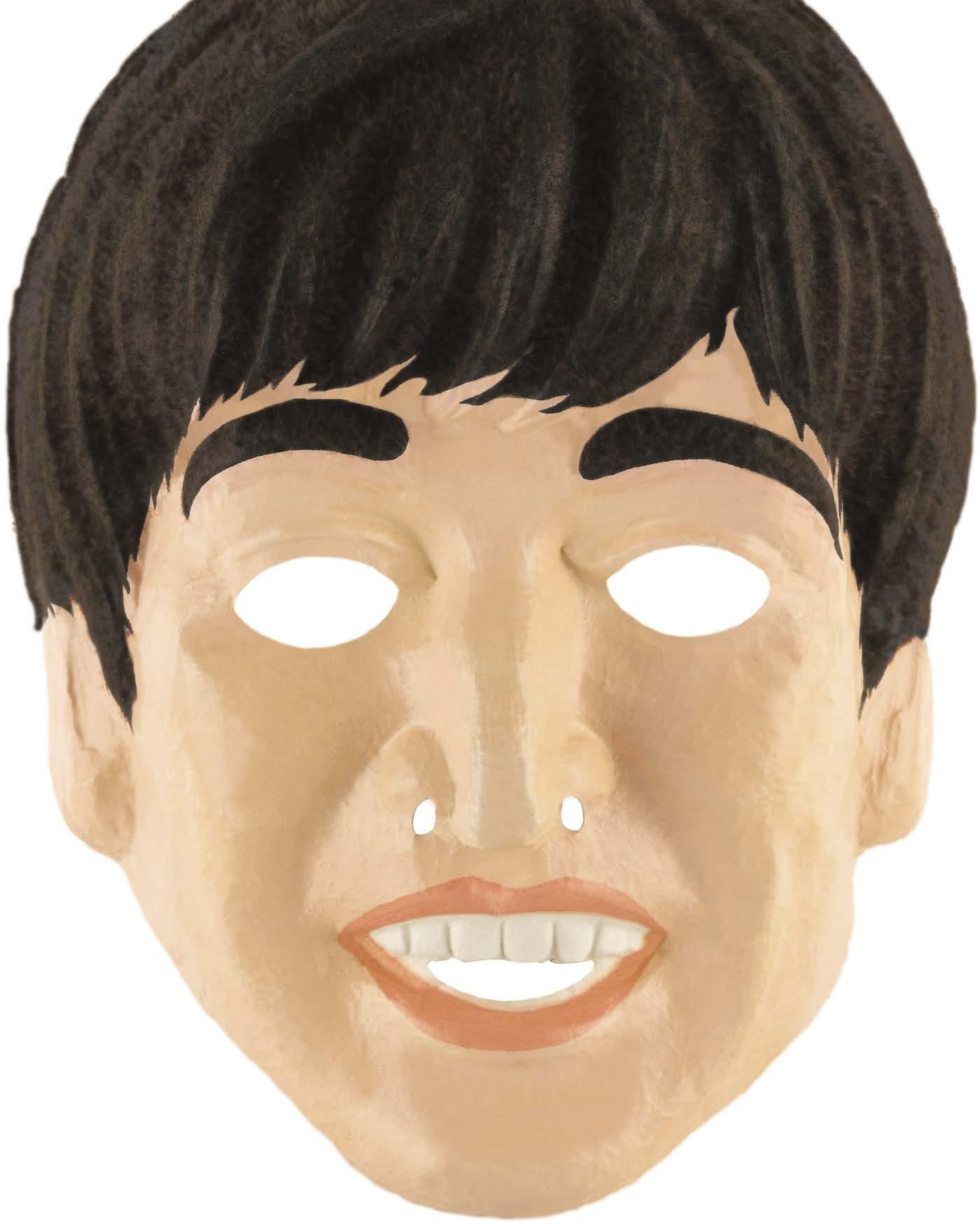

Ben Cooper costumes. Opposite: Soaky bubble bath toys.
© Ben Cooper; Lennon mask courtesy of Heritage Auctions; Soaky toys © Colgate
Take a bath with Paul and Ringo
When Ben Cooper — purveyors of chintzy (but enchanting) Halloween costumes — did the Beatles, they did ’em right. The boys were represented in good likenesses on BC’s crackly, rigid, nostril-blocking, sweat-trapping masks. (The “costumes,” glorified aprons in “rayon taffeta,” had the same striped vest for all four.)
But Colgate only rolled the dice on two Beatles in its Soaky line of bubble-bath toys. (Soakys were plastic figures filled with bubble-bath solution; the heads popped off to reveal a twist cap.) The two Beatles released by Colgate will hardly be a surprise: the Cute One, and the One With the Big Nose. (Pity those who wanted to take a bath with John or George.)
Another non-surprise: British Invasion-inspired collectibles overwhelmingly favored the Fab Four. But not all.
There were fan club buttons for the Rolling Stones, the Dave Clark Five, Herman’s Hermits, etc. Remco put out Dave Clark Five figures; Hasbro released a Peter Noone doll; and Play Pal released Rolling Stones dolls of ... we can’t say for sure.
Meanwhile, England was much more democratic than we Yanks when it came to rock collectibles. Selcol’s Stones-themed musical toys are like something from an alternate universe.
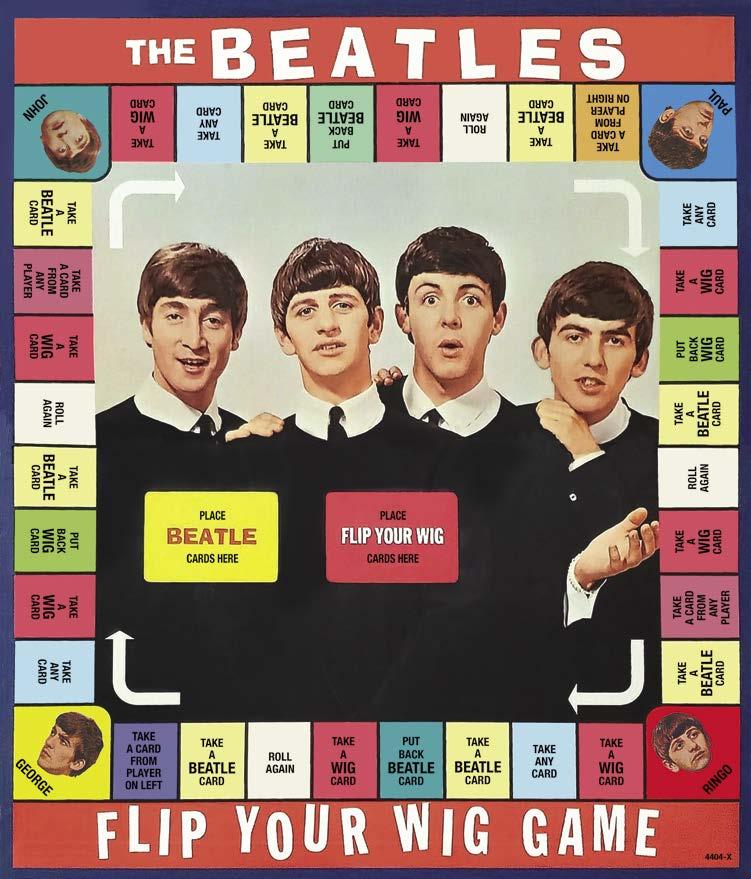
Game on!
The title of Milton Bradley’s “Flip Your Wig Game” focused on Beatle haircuts. But a photo of the boys before they perfected the hairstyle was used as the board’s main image. Like the band itself, MB’s game works best with four players. Participants play as John, Paul, George or Ringo, collecting cards with autographs, instruments and a “hit record” of whichever Beatle you represent. (Stratego, this ain’t.) Opposite: Band-emblazoned buttons.
Game © NEMS Enterprises Ltd. and © Milton Bradley; buttons © current copyright holders
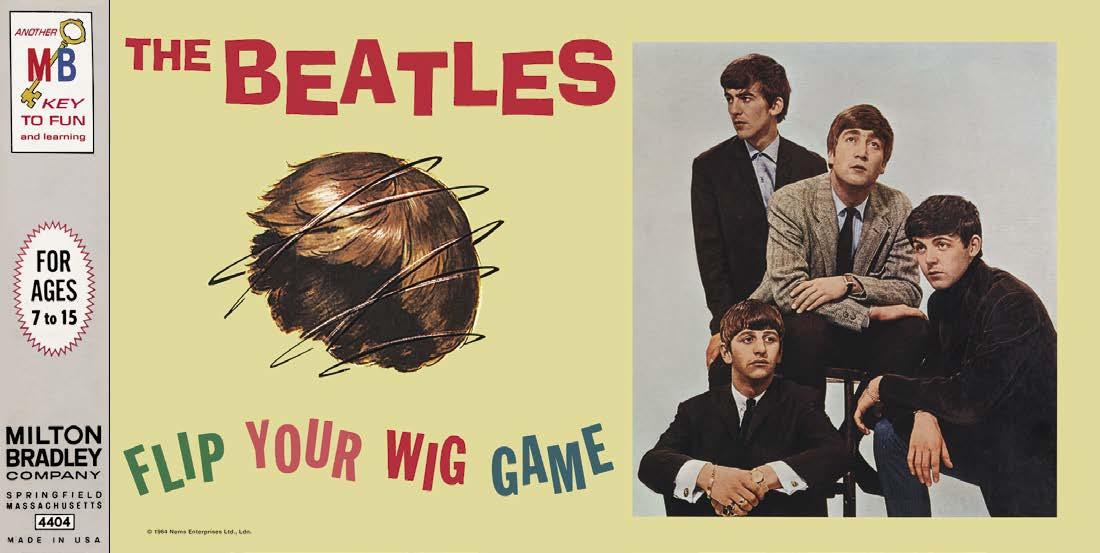
Remco’s darling, wiryhaired Beatle dolls from 1964 were hot sellers, but their likenesses ran hot and cold. John and Ringo were spot-on. But George had Prince Charles teeth, and Paul resembled a Zanti Misfit.
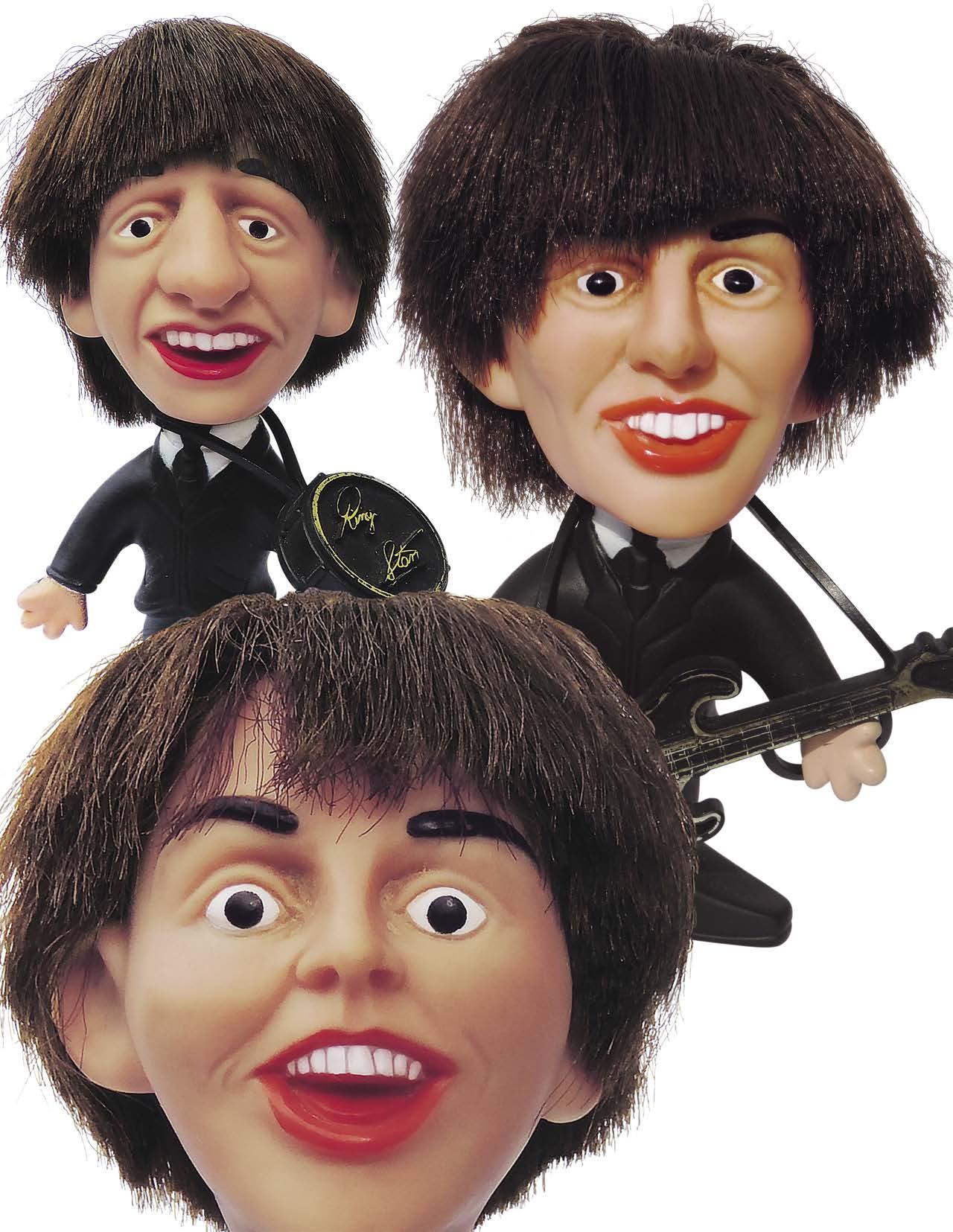
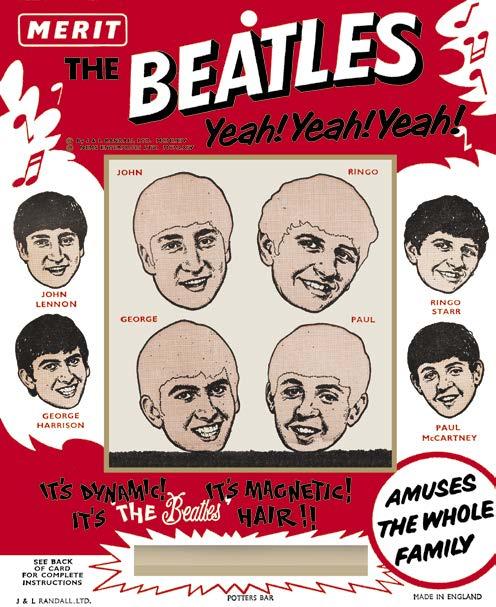
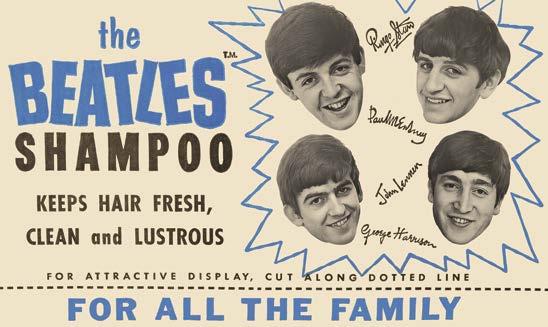
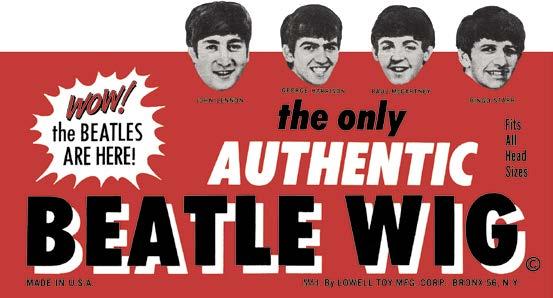
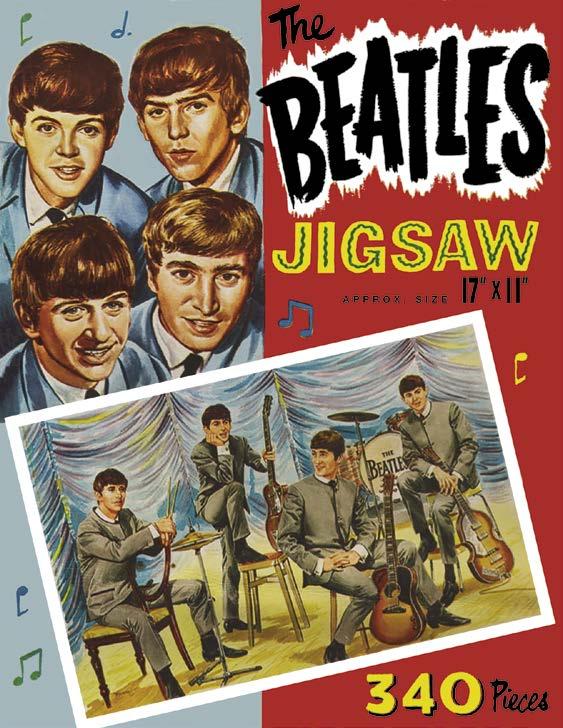
You name it
Brian Epstein was said to have been, shall we say, overly liberal in approving licensing deals on behalf of his young charges. In America, where the dollar is king, manufacturers seemed willing to plaster the Beatles’ names and faces on just about anything. From top left: Merit’s Beatles magnetic toy; packaging for the “only” Authentic Beatle Wig from Lowell; Bronson’s Beatles Shampoo (“for all the family”); a Beatles Jigsaw Puzzle; Bronson’s Beatles Hair Spray (“brushes out instantly”); and packaging for (probably unlicensed) Beatle Combs. Also for sale were Beatles stockings, pens, lariat ties, tie pins and (note careful spelling) “Beetle” boots.
© NEMS Enterprises Ltd.; © SELTAEB Inc.; © J & L Randall Ltd.; © Lowell Toy Mfg. Corp.; © Bronson Products Co.
